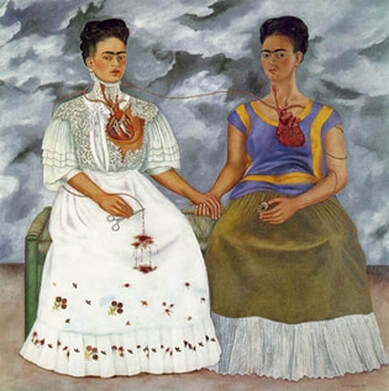|
Frida Kahlo: Inside and Out One Frida is the interior woman. And one Frida is the exterior. One Frida wears a lace blouse of myriad frills; these cut hundreds of dark spaces on her front which run into one another like a maze. And one Frida wears a silk blouse of lapis lazuli blue, banded gold down the shoulders and across the middle. The sheen off it catches and keeps the eye at the surface. One Frida has frills of blouse up to her chin, hiding her neck entirely. And one Frida bares her neck as if it were a pillar, flaunting its orange muscle. One Frida has stripped open her heart; we gaze into its chambers, down its dark hollows. We just can see the heads of channels that disappear into her body. Blood the heart held securely, as if never to let go, seeps onto her front. And one Frida has a whole, red heart, its smooth muscles massed together, no drop of blood to be seen. One Frida wears layered sleeves like hanging flower heads that cloak her arms modestly to the elbows. And one Frida bares arms that look like solid gold. One Frida wears a dress predominantly of white, colour of the untouched and the pure. Blood from her cut artery has stained it in two spots; no more intense a red could have coloured the fabric. Flowers, smaller than those spots, dot the rim of her dress. Their close, shy faces come in shades of blood red; many lie half-hidden in the dress's folds. And one Frida wears an olive dress, bunched tightly over her thighs; her spread knees press firmly against the fabric, more prominent, we believe, than if they were bared in the open. One Frida holds the scissors that cut open her heart, a thin, long artery she had worked from the flesh dangling on its steel tip. And one Frida holds a gold-rimmed miniature of her husband, poised in her fingers like a small coin to be admired. An artery coils about her arm like a binding strap. One Frida looks at us quietly with reserve as if moved from a thought of her own just a moment ago. The blush in her cheeks shows against her light face. And one Frida looks outward confidently, ready to meet our eye. Firmness marks her strongly coloured face. The Fridas form a great contrast, and it brings out the best qualities in both. We would not know the lace blouse of one to be as delicate unless we saw the solid blue and gold of the other's. We could not admire the neat heart of one as much unless the other had not stripped open her own. To appreciate one Frida lets us appreciate the other. They are bound together in that sense; we are sure of it as much as the women's obvious differences. Just note the artery about their shoulders, letting the blood of one flow into the other: they are one life. See how the two, equal in stature and dimension like the truest pair, hold hands as they sit side by side: they make one self. Norbert Kovacs Norbert Kovacs lives and writes in Hartford, Connecticut. He loves visiting art museums, especially the Met in New York. He has published stories recently in Blink-Ink, LIGEIA, and MacQueen's Quinterly. His website: www.norbertkovacs.net.
0 Comments
Your comment will be posted after it is approved.
Leave a Reply. |
The Ekphrastic Review
COOKIES/PRIVACY
This site uses cookies to deliver your best navigation experience this time and next. Continuing here means you consent to cookies. Thank you. Join us on Facebook:
July 2024
|




